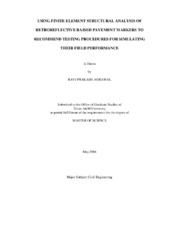| dc.contributor.advisor | Hawkins, Gene | |
| dc.creator | Agrawal, Ravi Prakash | |
| dc.date.accessioned | 2006-08-16T19:00:45Z | |
| dc.date.available | 2006-08-16T19:00:45Z | |
| dc.date.created | 2005-05 | |
| dc.date.issued | 2006-08-16 | |
| dc.identifier.uri | https://hdl.handle.net/1969.1/3730 | |
| dc.description.abstract | Retroreflective Raised Pavement Markers (RRPMs) supplement other pavement
markings to provide guidance to road users. Previous research concerning durability of
the RRPMs suggests that their performance has been degrading over the years. One of
the main causes for underperformance of the RRPMs is the lack of appropriate
laboratory testing standards that can test the adequacy of the RRPMs to perform in field
conditions. There is a need to modify the existing standards or develop new testing
procedures that can better simulate field conditions. This requires identifying critical
locations and magnitudes of stresses inside the markers during the tire-marker impacts
that happen on roads.
The goal of this research was to identify critical magnitudes and locations of the
stresses in RRPMs during the tire-marker impacts by doing the finite element modeling
and simulation of the impacts, and use the information to recommend laboratory testing
procedures that could simulate real-world conditions. The researcher modeled and
simulated the tire-marker impacts using the finite element tools Hypermesh and LS DYNA. He calibrated the material properties of the marker models to improve the tiremarker
model.
Based on the tire-marker impact simulations, the researcher concluded that the
critical compressive stresses during impacts are located at the edge contacts of
retroreflective sides with the top surface. The critical stresses may also occur at lower
and upper corners of the marker. The other areas, especially the lower half of the marker,
had tensile stresses. Angle of impact was found to be a critical external variable that
affected the stresses inside the markers and the marker-pavement interface forces.
The researcher then modeled and simulated a few laboratory-testing procedures
that could simulate the field performance of the RRPMs. Based on these simulations, the
researcher recommended that the ASTM compression test for evaluation of RRPMs be
continued or a similar test be developed. He suggested development of one new test
(named as offset compression test) that could better replicate the field conditions. He
also recommended having a review of the ASTM flexural test. | en |
| dc.format.extent | 8785109 bytes | en |
| dc.format.medium | electronic | en |
| dc.format.mimetype | application/pdf | |
| dc.language.iso | en_US | |
| dc.publisher | Texas A&M University | |
| dc.subject | retroreflective raised pavement marker | en |
| dc.subject | RRPM | en |
| dc.subject | RPM | en |
| dc.subject | tire-marker impact | en |
| dc.subject | finite element analysis | en |
| dc.subject | ASTM D4280 | en |
| dc.title | Using finite element analysis of retroreflective raised pavement markers to recommend testing procedures for simulating their field performance | en |
| dc.type | Book | en |
| dc.type | Thesis | en |
| thesis.degree.department | Civil Engineering | en |
| thesis.degree.discipline | Civil Engineering | en |
| thesis.degree.grantor | Texas A&M University | en |
| thesis.degree.name | Master of Science | en |
| thesis.degree.level | Masters | en |
| dc.contributor.committeeMember | Carlson, Paul | |
| dc.contributor.committeeMember | Hogan, Harry | |
| dc.contributor.committeeMember | Zhang, Yunlong | |
| dc.type.genre | Electronic Thesis | en |
| dc.type.material | text | en |
| dc.format.digitalOrigin | born digital | en |


